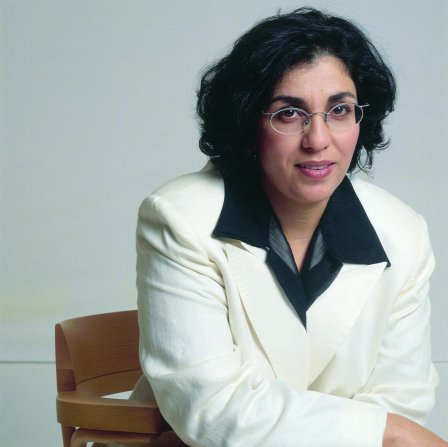New techniques developed by Weizmann Institute scientists in Rehovot, Israel, to study molecules in action may hold the key to cures for cancer and Alzheimer's disease. In fact, the first steps have already been taken to minimize the uncontrolled proliferation and spread of cancer cells.
At first glance, cancer and Alzheimer's disease appear to have little in common. Cancer is a group of over a hundred diseases in which cells grow out of control and spread throughout the body. Alzheimer's is a progressive neurodegenerative disease caused by the abnormal buildup of protein in the brain. The common link between the diseases is the role played by enzymes called proteases, which cut long strands of protein into fragments. Cancer cells secrete proteases that dissolve collagen, creating holes in the surrounding cell matrix that enable the cancer cells to bulldoze their way through tissue and into other cells. In Alzheimer's disease, insoluble fragments of a protein snipped from a larger protein by proteases accumulate in the brain, interfering with cognitive function and memory.
The proteases involved in both cancer and Alzheimer's disease utilize a zinc ion to execute their harmful activity. Because little information on how this works was available, Weizmann scientists decided to find out. They developed a method that enables the process to be seen in real time—that is, as it is actually taking place.

"We used high-intensity monochromatic x-rays to study the environment around a metal ion during protease activity," Prof. Irit Sagi explained to an audience of supporters of the American Committee for the Weizmann Institute of Science (ACWIS). "This allowed us to make molecular movies showing how a metal atom is activated inside a protease by water and other key protein residues. Our tools can be used to characterize the reaction elements that drive an increase in the rate of a chemical reaction in individual Alzheimer's and cancer enzymes."
Up to this point, scientists studying the workings of ultra-microscopic forms had to rely on the scientific equivalents of still photos, something like trying to fathom the concept of driving by looking at a photograph of a car. The resolution of Prof. Sagi's animated "video clips" of enzyme molecules at work is so fine that the scientists are able to see the movements of individual atoms within the molecule.
The challenge facing the Weizmann team was to capture, step-by-step, the complex process (the whole of which takes place in a tiny fraction of a second) that an enzyme molecule goes through as it performs its work. Their pioneering method, published in Nature Structural Biology, was hailed as the first of its kind, and a potentially important tool for biophysicists.
To obtain the "live action" footage, Prof. Sagi and her team use a technique akin to stop-action photography, but on an infinitely smaller scale. They literally freeze the process at certain stages, using advanced methods of chemical analysis to determine the exact molecular layout at each stage. The most difficult part, says Prof. Sagi, was figuring out the correct time frames that would allow them to see each phase of enzyme activity clearly. She compares it to attempting to capture on film the swirling of syrup being mixed into cake batter—one has to gauge the points at which individual stages of the process will be most visible.

Building an animated sequence from individual frames, the scientists are granted a rare peek into the intricate dance of life on the molecular level. "This method," says Prof. Sagi, "represents more than a major breakthrough in the techniques used to understand enzyme activity. It changes the whole paradigm of drug formulation. Now we can precisely identify which parts of the molecule are the active regions [those which directly perform tasks], and the exact permutations of these molecular segments throughout the whole process. New, synthetic drugs can be designed to target specific actions or critical configurations."
Prof. Sagi's team is doing just that for one enzyme family known to play a role in cancer metastasis. Matrix metalloproteinases (MMPs) assist the cancer cells' escape and entry into new tissues by breaking down the structural proteins that keep cells in place, a skill normally needed to clear out tissue in preparation for growth or repair.
The ability to visualize complex processes inside a molecule also paves the way for developing drugs that selectively stop the activity of metal ions—in this case, zinc—inside proteases. Prof. Sagi of the Weizmann Institute's Department of Structural Biology is working with the pharmaceutical company Novartis to translate this research into drug design. More than just a pipe dream, the information derived from these "molecular movies" has already been put to good use.
"We recently designed an antibody to block the activity of proteases by constraining the zinc-protein dynamics required for efficient enzyme activity, thereby minimizing uncontrolled collagen dissolving in cancer," says Prof. Sagi.
Prof. Irit Sagi's research is supported by the Clore Center for Biological Physics; the Helen and Milton A. Kimmelman Center for Biomolecular Structure and Assembly; the Joseph and Ceil Mazer Center for Structural Biology; the Avron-Wilstaetter Minerva Center; the Laub Fund for Oncogene Research; and Mr. and Mrs. Michael Ambach, Boca Raton, FL. Prof. Sagi is the incumbent of the Maurizio Pontecorvo Professorial Chair. The Weizmann Institute of Science in Rehovot, Israel, is one of the world's foremost centers of scientific research and graduate study. The American Committee for the Weizmann Institute of Science is a community of dedicated people who share a common vision in support of the Institute. The generous assistance the Institute receives from individuals, foundations, and corporations is vital for its future. Committee members show their devotion to the advancement of the Institute's goals by becoming partners in the search for answers to the most difficult challenges facing humanity.
